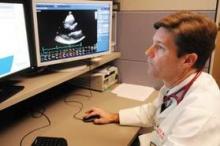NEW ORLEANS – Exercise training is the sole therapy that simultaneously addresses two of the major risk factors for secondary cardiovascular events in patients with known coronary heart disease: depression and sedentary lifestyle.
Despite this, formal cardiac rehabilitation programs, which as a matter of course place strong emphasis upon exercise training, are tremendously underutilized.
"My estimation is that only 5%-7% of CHD patients who are candidates actually attend a cardiac rehabilitation program. Even in the Medicare population – and Medicare covers cardiac rehabilitation – only 13% of post-MI patients, for example, attend cardiac rehabilitation," said Dr. Carl J. Lavie, a cardiologist who is medical director of cardiac rehabilitation and the exercise laboratories at the Ochsner Heart and Vascular Institute, New Orleans.
Because cardiac rehab for secondary prevention in CHD patients has been shown to reduce mortality, placebo-controlled randomized trials are no longer possible. But Dr. Lavie and Dr. Richard V. Milani, who is also with Ochsner, showed in a series of 522 consecutive patients enrolled in cardiac rehab that the prevalence of depression, as defined by a score greater than 6 on the well-validated Kellner Symptom Questionnaire, dropped from 17% at baseline to 6% upon completing the program. That’s a 63% reduction.
Moreover, at 5 years of follow-up, all-cause mortality was 22% among patients who remained depressed post-cardiac rehab, compared with 5% in nondepressed patients. And when the investigators analyzed their data based upon change in peak oxygen – a handy yardstick for cardiorespiratory fitness – during cardiac rehab and exercise training, they found it didn’t take much of a gain in VO2 max to obtain a significant mortality benefit. Five-year all-cause mortality was 6% in patients who achieved less than a 10% gain in VO2 max, compared with 4% in those with a more marked improvement in peak oxygen consumption and 15% in those with a VO2 loss (Am. J. Med. 2007;120:799-806).
More recently, the investigators evaluated the impact of exercise training and depression on survival in 189 patients with heart failure and a mean left ventricular ejection fraction of 35%. Among the 151 patients who completed a standard 12-week, 36-session formal cardiac rehab education and exercise training program, the prevalence of depression symptoms fell by 40%, from 22% at baseline to 13%. During a mean 4.6 years of follow-up, all-cause mortality in depressed patients with heart failure who didn’t complete the program was 44%, compared with 18% in depressed patients who did. Among patients depressed at baseline who remained so after completing cardiac rehab, long-term mortality was fourfold greater than in those whose depression resolved with rehab: 43% vs. 11% (Am. J. Cardiol. 2011;107:64-8).
So why isn’t cardiac rehab prescribed as often as, say, daily aspirin or statin therapy for secondary prevention?
"I still run into a tremendous number of internists and family physicians and cardiologists who haven’t totally bought into the role of psychologic stress in cardiovascular disease. And I think in your field of psychology, there’s probably a whole lot who haven’t bought into the importance of exercise training and cardiorespiratory fitness in preventing what is certainly the major cause of morbidity and mortality in the western world," Dr. Lavie declared at the annual meeting of the Society of Behavioral Medicine.
Dr. Lavie has been studying the antidepressant effects of cardiac rehab and exercise training for 20 years. At the meeting, he got together with prominent behavioral psychologists having lengthy experience in clinical trials for depression to assess the current standing of exercise training for secondary prevention in CHD and how best to advance the field.
For his physician colleagues who still question the role of psychologic stress in CHD, Dr. Lavie is quick to point to what he considers the most persuasive evidence: the landmark INTERHEART study.
"It really clinches things for many people who were skeptics," the cardiologist observed.
INTERHEART, led by Dr. Salim Yusuf of McMaster University in Hamilton, Ont., evaluated CHD risk factors in 11,119 MI patients and 13,648 age- and gender-matched controls at 262 centers in 52 countries. Among the nine major modifiable cardiovascular risk factors, psychologic stress ranked only behind serum lipids and smoking in importance. Indeed, psychologic stress accounted for one-third of the attributable risk of CHD (Lancet 2004; 364: 953-62).
Many physicians remain concerned about the transient increase in risks of acute MI and sudden cardiac death during physical exertion, but this issue has been blown way out of proportion, in Dr. Lavie’s view.


